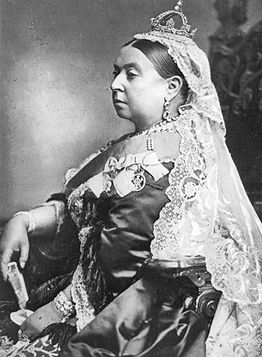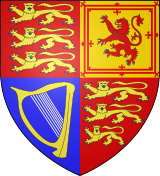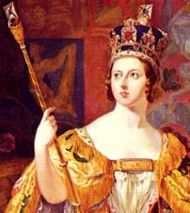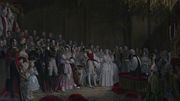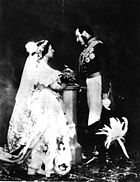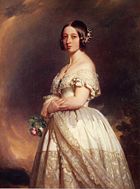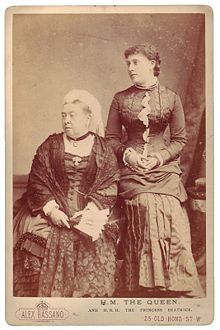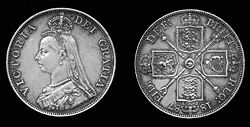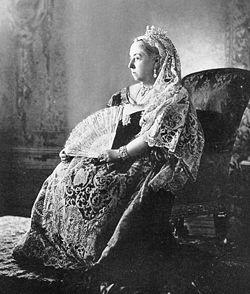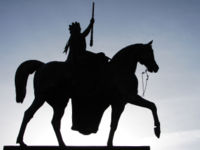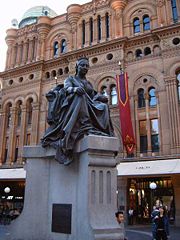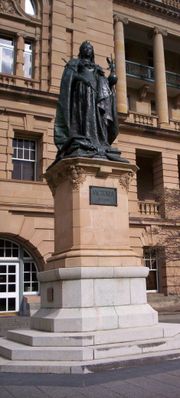Victoria of the United Kingdom
2008/9 Schools Wikipedia Selection. Related subjects: Historical figures; Monarchs of Great Britain
|
||||||||||||||||||||||||||||||||||||||||||||||
|
||||||||||||||||||||||||||||||||||||||||||||||
Victoria (Alexandrina Victoria; 24 May 1819 – 22 January 1901) was the Queen of the United Kingdom of Great Britain and Ireland from 20 June 1837, and the first Empress of India from 1 May 1876, until her death on 22 January 1901. Her reign lasted 63 years and seven months, longer than that of any other British monarch. The period centred on her reign is known as the Victorian era.
Though Victoria ascended the throne at a time when the United Kingdom was already an established constitutional monarchy in which the king or queen held few political powers, she still served as a very important symbolic figure of her time. The Victorian era represented the height of the Industrial Revolution, a period of significant social, economic, and technological progress in the United Kingdom. Victoria's reign was marked by a great expansion of the British Empire; during this period it reached its zenith, becoming the foremost global power of the time.
Victoria was the granddaughter of George III, and was a descendant of most major European royal houses. She arranged marriages for her children and grandchildren across the continent, tying Europe together. She was the last British monarch of the House of Hanover. Her son King Edward VII belonged to the House of Saxe-Coburg and Gotha.
Early life
At the age of 50, Edward, the Duke of Kent and Strathearn, the fourth son of George III, married a widow, Princess Victoria of Saxe-Coburg-Saalfeld. Victoria, the couple's only child, was born in Kensington Palace, London on 24 May 1819. At birth she was fifth in line for the British crown, but her grandfather was elderly, and his children had failed to produce legitimate issue.
Victoria was christened in the Cupola Room of Kensington Palace on 24 June 1819 by the Archbishop of Canterbury ( Charles Manners-Sutton). Her godparents were the Prince Regent, the Emperor Alexander I of Russia (in whose honour she received her first name), Princess Charlotte, Princess Royal and the Dowager Duchess of Saxe-Coburg-Saalfeld. Although christened Alexandrina Victoria - and from birth formally styled Her Royal Highness Princess Victoria of Kent - Victoria was called Drina within the family. She was taught German, English, Italian, Greek, Chinese, and French, arithmetic, music and her favourite subject, history. Her teachers were the Reverend George Davys and Baroness Louise Lehzen, her governess. When she learned from Baroness Lehzen that one day she could be queen, Victoria replied, "I will be good."
Her name, though finally agreed upon as Alexandrina Victoria, was disputed by her mother and uncles. King William IV proposed Elizabeth, while objecting to naming the princess for her mother, saying Victoria was "never known heretofore as a Christian name of this country." The Duchess of Kent refused. Charlotte was not even considered, out of respect for the dead princess.
Victoria's father died of after a brief illness, just eight months after she was born. Her grandfather, King George III, died six days later. Her uncle, the Prince of Wales, inherited the Crown, becoming King George IV, but he too died childless when Victoria was only 11. The crown now passed to his brother, the Duke of Clarence and St Andrews, who became King William IV.
Heiress to the Throne
King George III's eldest son, the Prince of Wales and future King George IV, had only one child, Princess Charlotte Augusta of Wales. When she died in 1817 the remaining unmarried sons of King George III scrambled to marry and father children to guarantee the line of succession.
Although William was the father of ten illegitimate children by his mistress, the actress Dorothy Jordan, he had no surviving legitimate children. As a result, the young Princess Victoria, his niece, became heiress presumptive.
The law at the time made no special provision for a child monarch. Therefore, a Regent needed to be appointed if Victoria were to succeed to the throne before coming of age at the age of eighteen. Parliament passed the Regency Act 1830, which provided that Victoria's mother, the Duchess of Kent and Strathearn, would act as Regent during the queen's minority. Parliament did not create a council to limit the powers of the Regent. King William disliked the Duchess and, on at least one occasion, stated that he wanted to live until Victoria's 18th birthday, so a regency could be avoided.
Albert of Saxe-Coburg and Gotha
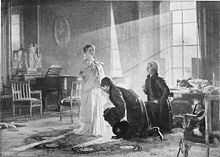
Princess Victoria met her future husband, Prince Albert of Saxe-Coburg and Gotha, when she was just 16 years old in 1836. But it was not until a second meeting in 1839 that she said of him, " …dear Albert… He is so sensible, so kind, and so good, and so amiable too. He has besides, the most pleasing and delightful exterior and appearance you can possibly see." Prince Albert was Victoria's first cousin; his father was her mother's brother, Ernst. As a monarch, Victoria had to propose to him. Their marriage proved to be very happy.
Early reign
Accession to the Throne
On 24 May 1837 Victoria turned 18, meaning that a regency was no longer necessary. On 20 June 1837, Victoria was awakened by her mother to find that William IV had died from heart failure at the age of 71. In her diary Victoria wrote, "I was awoke at 6 o'clock by Mamma …who told me the Archbishop of Canterbury and Lord Conyngham were here and wished to see me. I got out of bed and went into my sitting-room (only in my dressing gown) and alone, and saw them. Lord Conyngham then acquainted me that my poor Uncle, the King, was no more, and had expired at 12 minutes past 2 this morning, and consequently that I am Queen…" Victoria was now Queen of the United Kingdom. Her coronation took place on 28 June 1838.
Under Salic Law, however, no woman could be heir to the throne of Hanover, a realm which had shared a monarch with Britain since 1714. Hanover passed to her uncle, the Duke of Cumberland and Teviotdale, who became King Ernest Augustus I of Hanover.
As the young queen was as yet unmarried and childless, Ernest Augustus also remained the heir presumptive to the throne of the United Kingdom until her first child was born in 1840.
At the time of her accession, the government was controlled by the Whig Party, which had been in power, except for brief intervals, since 1830. The Whig Prime Minister, Lord Melbourne, at once became a powerful influence in the life of the politically inexperienced Queen, who relied on him for advice. (Some even referred to Victoria as "Mrs. Melbourne".) However, the Melbourne ministry would not stay in power for long; it was growing unpopular and, moreover, faced considerable difficulty in governing the British colonies (see Rebellions of 1837). In 1839 Lord Melbourne resigned.
Victoria's principal adviser was her uncle King Leopold I of Belgium (her mother's brother, and the widower of Princess Charlotte). Queen Victoria's cousins, through Leopold, were King Leopold II of Belgium and Empress Carlota of Mexico.
The Queen then commissioned Sir Robert Peel, a Tory, to form a new ministry, but was faced with a débâcle known as the Bedchamber Crisis. At the time, it was customary for appointments to the Royal Household to be based on the patronage system (that is, for the Prime Minister to appoint members of the Royal Household on the basis of their party loyalties). Many of the Queen's Ladies of the Bedchamber were wives of Whigs, but Sir Robert Peel expected to replace them with wives of Tories. Victoria strongly objected to the removal of these ladies, whom she regarded as close friends rather than as members of a ceremonial institution. Sir Robert Peel felt that he could not govern under the restrictions imposed by the Queen, and consequently resigned his commission, allowing Melbourne to return to office.
Marriage and assassination attempts
The Queen married her first cousin, Prince Albert, on 10 February 1840, in the Chapel Royal of St. James's Palace, London. Albert became not only the Queen's companion, but also an important political advisor, replacing Lord Melbourne as the dominant figure in the first half of her life.
During Victoria's first pregnancy, eighteen-year old Edward Oxford attempted to assassinate the Queen while she was riding in a carriage with Prince Albert in London. Oxford fired twice, but both bullets missed. He was tried for high treason, but was acquitted on the grounds of insanity. The shooting had no effect on the Queen's health or on her pregnancy and the first of the royal couple's nine children, named Victoria, was born on 21 November 1840.
Two further attempts to assassinate Queen Victoria occurred in May and July 1842:
On 29 May at St. James's Park, John Francis fired a pistol at the Queen while she was in a carriage, but was immediately seized by Police Constable William Trounce. Francis was convicted of high treason. The death sentence was commuted to transportation for life.
On 13 June 1842, Victoria made her first journey by train, travelling from Slough railway station (near Windsor Castle) to Bishop's Bridge, near Paddington (in London), in a special royal carriage provided by the Great Western Railway. Accompanying her were her husband and the engineer of the Great Western line, Isambard Kingdom Brunel. The Queen and Albert, Prince Consort, both complained the train was going far too fast at 20 mph (30 km/h), fearing the train would fall off the railway line.
On 3 July, just days after Francis' sentence was commuted, another boy, John William Bean, attempted to shoot the Queen. Prince Albert felt that the attempts were encouraged by Oxford's acquittal in 1840. Although his gun was loaded only with paper and tobacco, his crime was still punishable by death. Feeling that such a penalty would be too harsh, Prince Albert encouraged Parliament to pass the Treason Act of 1842. Under the new law, an assault with a dangerous weapon in the monarch's presence with the intent of alarming her was made punishable by seven years imprisonment and flogging. Bean was thus sentenced to 18 months' imprisonment; however, neither he, nor any person who violated the act in the future, was flogged.
Early Victorian politics and further assassination attempts
Peel's ministry soon faced a crisis involving the repeal of the Corn Laws. Many Tories - by then known also as Conservatives - were opposed to the repeal, but some Tories (the "Peelites") and most Whigs supported it. Peel resigned in 1846, after the repeal narrowly passed, and was replaced by Lord John Russell. Russell's ministry, though Whig, was not favoured by the Queen. Particularly offensive to Victoria was the Foreign Secretary, Lord Palmerston, who often acted without consulting the Cabinet, the Prime Minister, or the Queen.
In 1849, Victoria lodged a complaint with Lord John Russell, claiming that Palmerston had sent official dispatches to foreign leaders without her knowledge. She repeated her remonstrance in 1850, but to no avail. It was only in 1851 that Lord Palmerston was removed from office; he had on that occasion announced the British government's approval for President Louis-Napoleon Bonaparte's coup in France without prior consultation of the Prime Minister.
The period during which Russell was prime minister also proved personally distressing to Queen Victoria. In 1849, an unemployed and disgruntled Irishman named William Hamilton attempted to alarm the Queen by firing a powder-filled pistol as her carriage passed along Constitution Hill, London. Hamilton was charged under the 1842 act; he pleaded guilty and received the maximum sentence of seven years of penal transportation.
In 1850, the Queen did sustain injury when she was assaulted by a possibly insane ex-Army officer, Robert Pate. As Victoria was riding in a carriage, Pate struck her with his gun, crushing her bonnet and bruising her. Pate was later tried; he failed to prove his insanity, and received the same sentence as Hamilton.
Ireland
The young Queen Victoria fell in love with Ireland, choosing to holiday in Killarney in Kerry. Her love of the island was matched by initial Irish warmth towards the young Queen. In 1845, Ireland was hit by a potato blight that over four years cost the lives of over one million Irish people and saw the emigration of another million. In response to what came to be called the Irish Potato Famine (An Gorta Mór), the Queen personally donated 2000 pounds sterling to the starving Irish people.
The policies of her minister Lord John Russell were often blamed for exacerbating the severity of the famine, killing a million Irishmen, which adversely affected the Queen's popularity in Ireland.
Victoria was a strong supporter of the Irish. She supported the Maynooth Grant and made a point, on visiting Ireland, of visiting the seminary.
Victoria's first official visit to Ireland, in 1849, was specifically arranged by Lord Clarendon, the Lord Lieutenant of Ireland, the head of the British administration, to try both to draw attention off the famine and also to alert British politicians through the Queen's presence to the seriousness of the crisis in Ireland. Despite the negative impact of the famine on the Queen's popularity she remained popular enough for nationalists at party meetings to finish by singing God Save the Queen.
By the 1870s and 1880s the monarchy's appeal in Ireland had diminished substantially, partly because Victoria refused to visit Ireland in protest at the Dublin Corporation's decision not to congratulate her son, the Prince of Wales on both his marriage to Princess Alexandra of Denmark and on the birth of the royal couple's oldest son, Prince Albert Victor.
Victoria refused repeated pressure from a number of prime ministers, lords lieutenant and even members of the Royal Family, to establish a royal residence in Ireland. Lord Midleton, the former head of the Irish unionist party, writing in his memoirs of 1930 Ireland: Dupe or Heroine?, described this decision as having proved disastrous to the monarchy and British rule in Ireland.
Victoria paid her last visit to Ireland in 1900, when she came to appeal to Irishmen to join the British Army and fight in the Second Boer War. Nationalist opposition to her visit was spearheaded by Arthur Griffith, who established an organisation called Cumann na nGaedhael to unite the opposition. Five years later Griffith used the contacts established in his campaign against the queen's visit to form a new political movement, Sinn Féin.
Widowhood
Albert's death
Albert, the Prince Consort, died of typhoid fever on 14 December 1861 due to the primitive sanitary conditions of Windsor Castle. His death devastated Victoria, who entered a state of mourning and wore black for the remainder of her life. She avoided public appearances and rarely set foot in London in the following years. Her seclusion earned her the name "Widow of Windsor". She blamed her son Edward, the Prince of Wales, for his father's death, since news of the Prince's poor conduct had come to his father in November, leading Prince Albert to travel to Cambridge to confront his son.
Victoria's self-imposed isolation from the public greatly diminished the popularity of the monarchy, and even encouraged the growth of the republican movement. Although she did undertake her official government duties, she chose to remain secluded in her royal residences, Balmoral in Scotland, Osborne House on the Isle of Wight and Windsor Castle. During this time, one of the most important pieces of legislation of the nineteenth century — the Reform Act 1867 — was passed by Parliament. Lord Palmerston was vigorously opposed to electoral reform, but his ministry ended upon his death in 1865. He was followed by Earl Russell (the former Lord John Russell), and afterwards by Lord Derby, during whose ministry the Reform Act was passed.
Prime Minister Benjamin Disraeli was a staunch supporter of the expansion and preservation of the British Empire. He introduced the Royal Titles Act 1876 which created Queen Victoria Empress of India, raising her from queen to empress, the same level as the German Emperor and the Russian Tsar for the purposes of protocol.
John Brown
As time went by Victoria began to rely increasingly on a manservant from Scotland, John Brown. A romantic connection and even a secret marriage have been alleged, but both charges are generally discredited. However, when Victoria's remains were laid in the coffin, two sets of mementoes were placed with her, at her request. By her side was placed one of Albert's dressing gowns while in her left hand was placed a piece of Brown's hair, along with a picture of him. Rumours of an affair and marriage earned Victoria the nickname "Mrs Brown". The story of their relationship was the subject of the 1997 movie Mrs. Brown.
Later years
Golden Jubilee and an assassination attempt
In 1887, the British Empire celebrated Victoria's Golden Jubilee. Victoria marked the fiftieth anniversary of her accession, 20 June 1887, with a banquet to which 50 European kings and princes were invited. Although she could not have been aware of it, there was a plan - ostensibly by Irish anarchists - to blow up Westminster Abbey while the Queen attended a service of thanksgiving. This assassination attempt, when it was discovered, became known as The Jubilee Plot. On the next day, she participated in a procession that, in the words of Mark Twain, "stretched to the limit of sight in both directions". By this time, Victoria was once again an extremely popular monarch.
Diamond Jubilee
On 22 September 1896, Victoria surpassed George III as the longest reigning monarch in English, Scottish, and British history. The Queen requested all special public celebrations of the event to be delayed until 1897, to coincide with her Diamond Jubilee. The Colonial Secretary, Joseph Chamberlain, proposed that the Diamond Jubilee be made a festival of the British Empire.
The Prime Ministers of all the self-governing dominions and colonies were invited. The Queen's Diamond Jubilee procession included troops from every British colony and dominion, together with soldiers sent by Indian Princes and Chiefs as a mark of respect to Victoria, the Empress of India. The Diamond Jubilee celebration was an occasion marked by great outpourings of affection for the septuagenarian Queen. A service of thanksgiving was held outside St. Paul's Cathedral. Queen Victoria sat in her carriage throughout the service. Queen Victoria wore her usual black mourning dress trimmed with white lace.
Death
Following a custom she maintained throughout her widowhood Victoria spent Christmas at Osborne House on the Isle of Wight. She died there from a cerebral haemorrhage on 22 January 1901, at the age of 81. At her deathbed she was attended by her son, the future King, and her oldest grandson, German Emperor William II. As she had wished, her own sons lifted her into the coffin. She was dressed in a white dress and her wedding veil. Her funeral was held on 2 February, and after two days of lying-in-state, she was interred beside Prince Albert in the Frogmore Mausoleum at Windsor Great Park. Since Victoria disliked black funerals, London was instead festooned in purple and white. When she was laid to rest at Frogmore Mausoleum, it began to snow. Victoria had reigned for a total of 63 years, seven months and two days—the longest of any British monarch.
Succession
Victoria's death brought an end to the rule of the House of Hanover in the United Kingdom. As her husband belonged to the House of Saxe-Coburg and Gotha, her son and heir Edward VII was the first British monarch of this new house.
Legacy

Queen Victoria's reign marked the gradual establishment of modern constitutional monarchy. A series of legal reforms saw the House of Commons' power increase, at the expense of the House of Lords and the monarchy, with the monarch's role becoming gradually more symbolic. Since Victoria's reign the monarch has had only, in Walter Bagehot's words, "the right to be consulted, the right to advise, and the right to warn".
As Victoria's monarchy became more symbolic than political, it placed a strong emphasis on morality and family values, in contrast to the sexual, financial and personal scandals that had been associated with previous members of the House of Hanover and which had discredited the monarchy. Victoria's reign created for Britain the concept of the 'family monarchy' with which the burgeoning middle classes could identify.
Internationally Victoria was a major figure, not just in image or in terms of Britain's influence through the empire, but also because of family links throughout Europe's royal families, earning her the affectionate nickname "the grandmother of Europe". For example, three of the main monarchs with countries involved in the First World War on the opposing side were either grandchildren of Victoria's or married to a grandchild of hers. Eight of Victoria's nine children married members of European royal families, and the other, Princess Louise, married the Marquis of Lorne, a future Governor-General of Canada.
Victoria was the first known carrier of haemophilia in the royal line. It is unclear how she acquired the gene. Since no haemophiliacs were among her known ancestors, hers was quite possibly an instance of spontaneous mutation, which account for about ⅓ of all haemophilia A and 20% of all haemophilia B cases. Evidence indicates Victoria passed the gene on to two of her five daughters: Princess Alice and Princess Beatrice. Her son, Prince Leopold was affected by the disease. The most famous haemophilia victims among her descendants were her great-grandson, Alexei, Tsarevich of Russia and some of the sons of King Alfonso XIII and Queen Victoria Eugenia of Spain (Victoria's granddaughter).
As of 2007, the European monarchs and former monarchs descended from Victoria are: Queen Elizabeth II of the United Kingdom (as well as her husband), the King of Norway, the King of Sweden, the Queen of Denmark, the King of Spain, the former King of the Hellenes and the former King of Romania (deposed). The pretenders to the thrones of Serbia, Russia, Prussia and Germany, Saxe-Coburg and Gotha, Hanover, Hesse, Baden and France (Legitimist) are also descendants.
Queen Victoria experienced unpopularity during the first years of her widowhood, but afterwards became extremely well-liked during the 1880s and 1890s. In 2002, the British Broadcasting Corporation conducted a poll regarding the 100 Greatest Britons; Victoria attained the eighteenth place.
Innovations of the Victorian era include postage stamps, the first of which—the Penny Black (issued 1840)—featured an image of the Queen, and the railway, which Victoria was the first British Sovereign to ride.
Several places in the world have been named after Victoria, including two Australian States ( Victoria and Queensland), the capitals of British Columbia ( Victoria, British Columbia), and Saskatchewan ( Regina), the capital of the Seychelles, Africa's largest lake, and Victoria Falls. See also List of places named after Queen Victoria.
Victoria Day is a Canadian statutory holiday celebrated on the last Monday before or on May 24 in honour of both Queen Victoria's birthday and the current reigning Canadian Sovereign's birthday. While Victoria Day is often thought of as a purely Canadian event, it is also celebrated in some parts of Scotland, particularly in Edinburgh and Dundee, where it is also a public holiday.
Queen Victoria remains the most commemorated British monarch in history, with statues to her erected throughout the former territories of the British Empire. These range from the prominent, such as the Victoria Memorial outside Buckingham Palace, which was erected as part of the remodelling of the façade of the Palace a decade after her death, to the obscure: in the town of Cape Coast, Ghana, a bust of the Queen presides, rather forlornly, over a small park where goats graze around her. Many institutions, thoroughfares, parks, and structures bear her name. See also Victoria (disambiguation).
Post-colonial sensitivities have led to the removal of Victoria's image and name from some of these legacies. For instance, probably the grandest train station and terminus in Mumbai (Formerly Bombay) India, Victoria Terminus, has been renamed after the seventeenth century Maratha King Chhatrapati Shivaji. A famous engineering college in the same city, Victoria Jubilee Technical Institute (VJTI) has been cleverly renamed after the queen mother of king Shivaji, Jijabai: the new name Veermata Jijabai Technical Institute retains the same well known abbreviation, VJTI. The statue of Queen Victoria sculpted by Irishman John Hughes, erected in front of Leinster House in Dublin in 1924, was removed in 1947 after years of criticism that it was inappropriate to have the British Queen's likeness stand in front of the Oireachtas, the parliament of the Irish Free State. After decades in storage the statue was given by Ireland to Australia and unveiled on 20 December 1987 to stand outside the Queen Victoria Building in the centre of Sydney, capital city of the Australian state of New South Wales.
There is a statue of Queen Victoria in Victoria Square in Adelaide, capital city of the Australian state of South Australia; in Queen's Square in Brisbane, capital city of the Australian state of Queensland; and in the Domain Gardens in Melbourne, the capital of the Australian State of Victoria. A bronze statue of Queen Victoria stands in the main street of the city of Ballarat in Victoria, Australia. At Bangalore, India, the statue of the Queen stands at the beginning of MG Road, one of the city's major roads.
Titles, styles, coat of arms and cypher
Titles and styles
- 24 May 1819– 20 June 1837: Her Royal Highness Princess Victoria of Kent
- 20 June 1837– 22 January 1901: Her Majesty The Queen
- 1 May 1876– 22 January 1901: Her Imperial Majesty The Empress of India
As the male-line granddaughter of a King of Hanover, Victoria also bore the titles of Princess of Hanover and Duchess of Brunswick and Lunenburg. In addition, she held the titles of Princess of Saxe-Coburg and Gotha and Duchess in Saxony, etc, as the wife of Prince Albert.
Coat of arms
Victoria's coat of arms were: Quarterly, I and IV Gules three lions passant guardant in pale Or (for England); II Or a lion rampant within a double tressure flory-counter-flory Gules (for Scotland); III Azure a harp Or stringed Argent (for Ireland). This same coat of arms has been used by every subsequent British monarch.
Royal Cypher
Victoria's Royal Cypher was the first to be used on a postbox. The letters are "VR" interlaced, standing for Victoria Regina. Although Victoria eventually used the cypher "VRI" (Victoria Regina Imperatrix) when she became Empress, this never appeared on postboxes. Victoria's cypher is the only one to appear on postboxes without a crown above it.
Issue
| Name | Birth | Death | Notes |
|---|---|---|---|
| The Princess Victoria, Princess Royal | 21 November 1840 | 5 August 1901 | Married 1858, Friedrich III, German Emperor and King of Prussia; had issue. |
| King Edward VII | 9 November 1841 | 6 May 1910 | Married 1863, Princess Alexandra of Denmark; had issue. |
| The Princess Alice | 25 April 1843 | 14 December 1878 | Married 1862, Ludwig IV, Grand Duke of Hesse and by Rhine; had issue. |
| The Prince Alfred, Duke of Saxe-Coburg and Gotha and Duke of Edinburgh | 6 August 1844 | 31 July 1900 | Married 1874, Grand Duchess Marie Alexandrovna of Russia; had issue. |
| The Princess Helena | 25 May 1846 | 9 June 1923 | Married 1866, Prince Christian of Schleswig-Holstein-Sonderburg-Augustenburg; had issue. |
| The Princess Louise | 18 March 1848 | 3 December 1939 | Married 1871, John Douglas Sutherland Campbell, 9th Duke of Argyll; no issue. |
| The Prince Arthur, Duke of Connaught and Strathearn | 1 May 1850 | 16 January 1942 | Married 1879, Princess Louise Margarete of Prussia; had issue. |
| The Prince Leopold, Duke of Albany | 7 April 1853 | 28 March 1884 | Married 1882, Princess Helena of Waldeck and Pyrmont; had issue. |
| The Princess Beatrice | 14 April 1857 | 26 October 1944 | Married 1885, Prince Henry of Battenberg; had issue. |
Ancestry
|
|
||||||||||||||||||||||||||||||||||||||||||||||||||||||||||||||||||||||||||||||||||||||||||||||||||||||||||||||||||||||||||||||||||||||||||||||||||||||||||||||||||||||||||||||||||||||||||||||||||||||||||||||||||||||||||||||||||||||||||||||||||||||||||||||||||||||||||||||||||||||||||||||||||||||||||||||||||||||||||||||||||||||||||||||||||||||||||||||||||||||||||||||||||||||||||||||||||||||||||||||||||||||||||||||||||||||||||||||||||||||||||||||||||||||||||||||||||||||||||||||||||||||||||||||||||||||||||||||||||||||||||||||||||||||||||||||||||
|---|---|---|---|---|---|---|---|---|---|---|---|---|---|---|---|---|---|---|---|---|---|---|---|---|---|---|---|---|---|---|---|---|---|---|---|---|---|---|---|---|---|---|---|---|---|---|---|---|---|---|---|---|---|---|---|---|---|---|---|---|---|---|---|---|---|---|---|---|---|---|---|---|---|---|---|---|---|---|---|---|---|---|---|---|---|---|---|---|---|---|---|---|---|---|---|---|---|---|---|---|---|---|---|---|---|---|---|---|---|---|---|---|---|---|---|---|---|---|---|---|---|---|---|---|---|---|---|---|---|---|---|---|---|---|---|---|---|---|---|---|---|---|---|---|---|---|---|---|---|---|---|---|---|---|---|---|---|---|---|---|---|---|---|---|---|---|---|---|---|---|---|---|---|---|---|---|---|---|---|---|---|---|---|---|---|---|---|---|---|---|---|---|---|---|---|---|---|---|---|---|---|---|---|---|---|---|---|---|---|---|---|---|---|---|---|---|---|---|---|---|---|---|---|---|---|---|---|---|---|---|---|---|---|---|---|---|---|---|---|---|---|---|---|---|---|---|---|---|---|---|---|---|---|---|---|---|---|---|---|---|---|---|---|---|---|---|---|---|---|---|---|---|---|---|---|---|---|---|---|---|---|---|---|---|---|---|---|---|---|---|---|---|---|---|---|---|---|---|---|---|---|---|---|---|---|---|---|---|---|---|---|---|---|---|---|---|---|---|---|---|---|---|---|---|---|---|---|---|---|---|---|---|---|---|---|---|---|---|---|---|---|---|---|---|---|---|---|---|---|---|---|---|---|---|---|---|---|---|---|---|---|---|---|---|---|---|---|---|---|---|---|---|---|---|---|---|---|---|---|---|---|---|---|---|---|---|---|---|---|---|---|---|---|---|---|---|---|---|---|---|---|---|---|---|---|---|---|---|---|---|---|---|---|---|---|---|---|---|---|---|---|---|---|---|---|---|---|---|---|---|---|---|---|---|---|---|---|---|---|---|---|---|---|---|---|---|---|---|---|---|---|---|---|---|---|---|---|---|---|---|---|---|---|---|---|---|---|---|---|---|---|---|---|---|---|---|---|---|---|---|---|---|---|---|---|---|---|---|---|---|---|---|---|---|---|---|---|---|---|---|---|---|---|---|---|---|---|---|---|---|---|---|---|---|---|---|---|---|---|---|---|---|---|---|---|---|---|---|---|---|---|---|---|---|---|---|---|---|---|---|---|---|---|---|---|---|
|
||||||||||||||||||||||||||||||||||||||||||||||||||||||||||||||||||||||||||||||||||||||||||||||||||||||||||||||||||||||||||||||||||||||||||||||||||||||||||||||||||||||||||||||||||||||||||||||||||||||||||||||||||||||||||||||||||||||||||||||||||||||||||||||||||||||||||||||||||||||||||||||||||||||||||||||||||||||||||||||||||||||||||||||||||||||||||||||||||||||||||||||||||||||||||||||||||||||||||||||||||||||||||||||||||||||||||||||||||||||||||||||||||||||||||||||||||||||||||||||||||||||||||||||||||||||||||||||||||||||||||||||||||||||||||||||||||
Biographic details
When Queen Victoria died in 1901, at the age of 81, her own sons lifted her into the coffin. She wore a white dress and her wedding veil. Because Victoria had disliked black funerals, London was decorated in purple and white. Her last words were "Oh that peace may come. Bertie!"
She surpassed her grandfather King George III as the longest-lived British monarch when she reached the age of 81 years and 240 days on 19 January 1901, only three days before her death. She has since been surpassed by her great-great granddaughter Elizabeth II on December 21, 2007. Victoria spent over three-quarters of her life as Queen, the highest ratio of any British monarch since the Restoration in 1660.
She outlived three of her nine children, and came within seven months of outliving a fourth (her eldest daughter, Vicky, who died of spinal cancer in August 1901 aged 60). She outlived eleven of her 42 grandchildren (two stillborn, six as children, and three as adults), and three of her 88 great-grandchildren. Upon the recent death of Lady Katherine Brandram on 2 October 2007, there is just one remaining great-grandchild of Queen Victoria who is still living: Count Carl Johan Bernadotte of Sweden, who recently celebrated his 90th birthday.
The Queen and all her female-line descendants are known to be members of mitochondrial haplogroup H.
- The design of the Queen's head on the first postage stamp was based upon the 1837 Wyon City medal engraved by a famous coin engraver William Wyon. The design of Queen Victoria's head is based on a sitting when she was a princess aged 15.
- Queen Victoria was 20 when the Penny Black stamp was issued on 6 May 1840. Her profile on British stamps never aged; the design of her head remained the same for 60 years.
- Prince Albert introduced Christmas trees to the court and this was soon copied by Victoria's subjects.
- Every day for forty years after her Prince Consort had died, the Queen ordered that his clothes be laid afresh on his bed in his suite at Windsor Castle.
- Queen Victoria was known to the Blackfoot Nation as Ninaki or Chief Woman, while the common expression for her was Great Mother.
- After one of the attempts on her life, an armoured parasol was designed for her; it had a layer of chain mail between its cover and lining. The armour made it weigh more than three pounds, and it probably did not see any use.
- Queen Victoria was the only world leader to respond positively to messages that were sent to 19th century monarchs by Bahá'u'lláh, the founder of the Bahá'í Faith, inviting them to establish a " Most Great Peace".
- Queen Victoria started the tradition of a bride wearing a white dress at her wedding. Before Victoria's wedding a bride would wear her best dress of no particular colour.
- Queen Victoria was the first sovereign to take up residence at Buckingham Palace, in 1837.
Books and additional materials
- Auchincloss, Louis. Persons of Consequence: Queen Victoria and Her Circle. Random House, 1979. ISBN 0-394-50427-5
- Cecil, Algernon. Queen Victoria and Her Prime Ministers. Eyre and Spottiswode, 1953.
- Benson, Arthur Christopher & Esher (Viscount). The Letters of Queen Victoria: A Selection From Her Majesty's Correspondence Between The Years 1837 and 1861. John Murray, 1908
- Eilers, Marlene A. Queen Victoria’s Descendants. 2d enlarged & updated ed. Falköping, Sweden: Rosvall Royall Books, 1997. ISBN 0-8063-1202-5
- Farnborough, T. E. May (1st Baron). Constitutional History of England since the Accession of George the Third. 11th ed. Longmans, Green, 1896.
- Hibbert, Christopher. Victoria: A Biography. George Rainbird Ltd, 1979. ISBN 0 7296 0207 9
- Hibbert, Christopher. Queen Victoria: A Personal History. Harper Collins Publishing, 2000.
- Hicks, Kyra E. "Martha Ann's Quilt for Queen Victoria". Brown Books, 2007. ISBN 978-1-933285-59-7
- Marshall, Dorothy. The Life and Times of Queen Victoria. George Weidenfeld and Nicolson Ltd, 1972.
- Packard, Jerrold, M. Victoria's Daughters. St. Martin's Press, 1998. ISBN 0 312 24496 7
- Potts, D. M. & W. T. W. Potts. Queen Victoria’s Gene: Haemophilia and the Royal Family. Alan Sutton, 1995. ISBN 0-7509-1199-9
- St. Aubyn, Giles. Queen Victoria: A Portrait. Sinclair-Stevenson, 1991. ISBN 1 85619 086 2
- Strachey, Lytton. Queen Victoria. Londres, Chatto et Windus Publishers, 1921. ISBN 2-228-88610-6
- Waller, Maureen, "Sovereign Ladies: Sex, Sacrifice, and Power. The Six Reigning Queens of England." St. Martin's Press, New York, 2006. ISBN 0-312-33801-5
- The Royal Household. (2004). "Victoria." Official Website of the British Monarchy.
- "Queen Victoria." Encyclopædia Britannica. 11th ed. Cambridge University Press, 1911.
